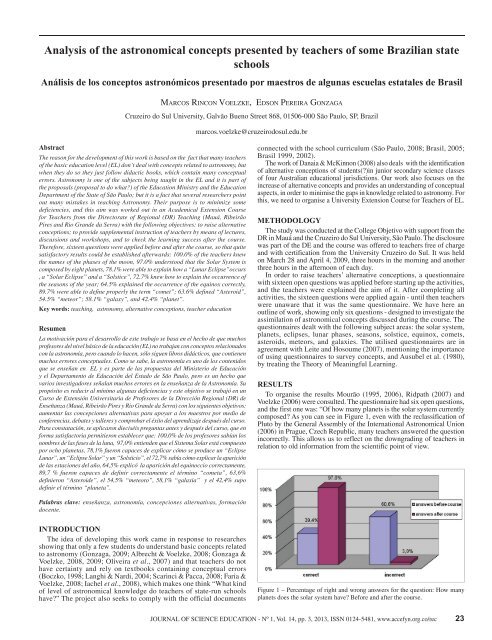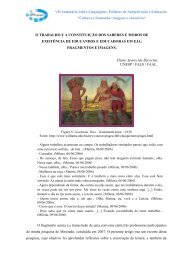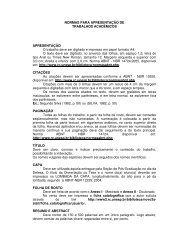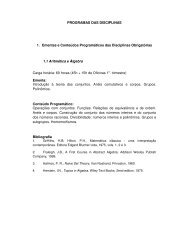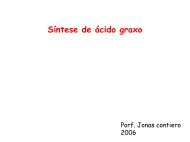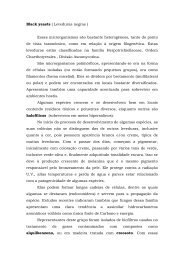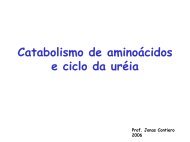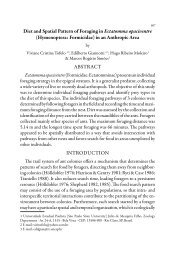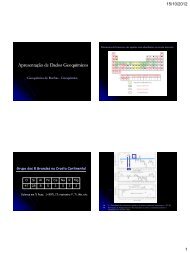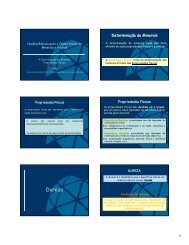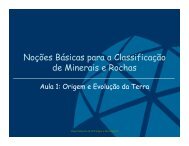Vol. 14 N° 1, 2013 - UNESP Rio Claro
Vol. 14 N° 1, 2013 - UNESP Rio Claro
Vol. 14 N° 1, 2013 - UNESP Rio Claro
You also want an ePaper? Increase the reach of your titles
YUMPU automatically turns print PDFs into web optimized ePapers that Google loves.
Analysis of the astronomical concepts presented by teachers of some Brazilian state<br />
schools<br />
Análisis de los conceptos astronómicos presentado por maestros de algunas escuelas estatales de Brasil<br />
marCos rInCon Voelzke, eDson PereIra GonzaGa<br />
Cruzeiro do Sul University, Galvão Bueno Street 868, 01506-000 São Paulo, SP, Brazil<br />
marcos.voelzke@cruzeirodosul.edu.br<br />
Abstract<br />
The reason for the development of this work is based on the fact that many teachers<br />
of the basic education level (EL) dont deal with concepts related to astronomy, but<br />
when they do so they just follow didactic books, which contain many conceptual<br />
errors. Astronomy is one of the subjects being taught in the EL and it is part of<br />
the proposals (proposal to do what?) of the Education Ministry and the Education<br />
Department of the State of São Paulo; but it is a fact that several researchers point<br />
out many mistakes in teaching Astronomy. Their purpose is to minimize some<br />
deficiencies, and this aim was worked out in an Academical Extension Course<br />
for Teachers from the Directorate of Regional (DR) Teaching (Mauá, Ribeirão<br />
Pires and <strong>Rio</strong> Grande da Serra) with the following objectives: to raise alternative<br />
conceptions; to provide supplemental instruction of teachers by means of lectures,<br />
discussions and workshops, and to check the learning success after the course.<br />
Therefore, sixteen questions were applied before and after the course, so that quite<br />
satisfactory results could be established afterwards: 100.0% of the teachers knew<br />
the names of the phases of the moon, 97.0% understood that the Solar System is<br />
composed by eight planets, 78.1% were able to explain how a Lunar Eclipseoccurs<br />
, a Solar Eclipse and a Solstice, 72.7% knew how to explain the occurrence of<br />
the seasons of the year; 64.5% explained the occurrence of the equinox correctly,<br />
89.7% were able to define properly the term comet; 63.6% defined Asteroid,<br />
54.5% meteor; 58.1% galaxy, and 42.4% planet.<br />
Key words: teaching, astronomy, alternative conceptions, teacher education<br />
Resumen<br />
La motivación para el desarrollo de este trabajo se basa en el hecho de que muchos<br />
profesores del nivel básico de la educación (EL) no trabajan con conceptos relacionados<br />
con la astronomía, pero cuando lo hacen, sólo siguen libros didácticos, que contienen<br />
muchos errores conceptuales. Como se sabe, la astronomía es uno de los contenidos<br />
que se enseñan en EL y es parte de las propuestas del Ministerio de Educación<br />
y el Departamento de Educación del Estado de São Paulo, pero es un hecho que<br />
varios investigadores señalan muchos errores en la enseñanza de la Astronomía. Su<br />
propósito es reducir al mínimo algunas deficiencias y este objetivo se trabajó en un<br />
Curso de Extensión Universitaria de Profesores de la Dirección Regional (DR) de<br />
Enseñanza (Mauá, Ribeirão Pires y <strong>Rio</strong> Grande da Serra) con los siguientes objetivos:<br />
aumentar las concepciones alternativas para apoyar a los maestros por medio de<br />
conferencias, debates y talleres y comprobar el éxito del aprendizaje después del curso.<br />
Para constatación, se aplicaron dieciséis preguntas antes y después del curso, que en<br />
forma satisfactoria permitieron establecer que: 100,0% de los profesores sabían los<br />
nombres de las fases de la luna, 97,0% entienden que el Sistema Solar está compuesto<br />
por ocho planetas, 78,1% fueron capaces de explicar cómo se produce un Eclipse<br />
Lunar, un Eclipse Solar y un Solsticio, el 72,7% sabía cómo explicar la aparición<br />
de las estaciones del año, 64,5% explicó la aparición del equinoccio correctamente,<br />
89,7 % fueron capaces de definir correctamente el término cometa, 63,6%<br />
definieron Asteroide, el 54,5% meteoro, 58,1% galaxia y el 42,4% supo<br />
definir el término planeta.<br />
connected with the school curriculum (São Paulo, 2008; Brasil, 2005;<br />
Brasil 1999, 2002).<br />
The work of Danaia & McKinnon (2008) also deals with the identification<br />
of alternative conceptions of students(?)in junior secondary science classes<br />
of four Australian educational jurisdictions. Our work also focuses on the<br />
increase of alternative concepts and provides an understanding of conceptual<br />
aspects, in order to minimise the gaps in knowledge related to astronomy. For<br />
this, we need to organise a University Extension Course for Teachers of EL.<br />
METHODOLOGY<br />
The study was conducted at the College Objetivo with support from the<br />
DR in Mauá and the Cruzeiro do Sul University, São Paulo. The disclosure<br />
was part of the DE and the course was offered to teachers free of charge<br />
and with certification from the University Cruzeiro do Sul. It was held<br />
on March 28 and April 4, 2009, three hours in the morning and another<br />
three hours in the afternoon of each day.<br />
In order to raise teachers’ alternative conceptions, a questionnaire<br />
with sixteen open questions was applied before starting up the activities,<br />
and the teachers were explained the aim of it. After completing all<br />
activities, the sixteen questions were applied again - until then teachers<br />
were unaware that it was the same questionnaire. We have here an<br />
outline of work, showing only six questions - designed to investigate the<br />
assimilation of astronomical concepts discussed during the course. The<br />
questionnaires dealt with the following subject areas: the solar system,<br />
planets, eclipses, lunar phases, seasons, solstice, equinox, comets,<br />
asteroids, meteors, and galaxies. The utilised questionnaires are in<br />
agreement with Leite and Hosoume (2007), mentioning the importance<br />
of using questionnaires to survey concepts, and Ausubel et al. (1980),<br />
by treating the Theory of Meaningful Learning.<br />
RESULTS<br />
To organise the results Mourão (1995, 2006), Ridpath (2007) and<br />
Voelzke (2006) were consulted. The questionnaire had six open questions,<br />
and the first one was: “Of how many planets is the solar system currently<br />
composed? As you can see in Figure 1, even with the reclassification of<br />
Pluto by the General Assembly of the International Astronomical Union<br />
(2006) in Prague, Czech Republic, many teachers answered the question<br />
incorrectly. This allows us to reflect on the downgrading of teachers in<br />
relation to old information from the scientific point of view.<br />
Palabras clave: enseñanza, astronomía, concepciones alternativas, formación<br />
docente.<br />
INTRODUCTION<br />
The idea of developing this work came in response to researches<br />
showing that only a few students do understand basic concepts related<br />
to astronomy (Gonzaga, 2009; Albrecht & Voelzke, 2008; Gonzaga &<br />
Voelzke, 2008, 2009; Oliveira et al., 2007) and that teachers do not<br />
have certainty and rely on textbooks containing conceptual errors<br />
(Boczko, 1998; Langhi & Nardi, 2004; Scarinci & Pacca, 2008; Faria &<br />
Voelzke, 2008; Iachel et al., 2008), which makes one think “What kind<br />
of level of astronomical knowledge do teachers of state-run schools<br />
have?” The project also seeks to comply with the official documents<br />
Figure 1 – Percentage of right and wrong answers for the question: How many<br />
planets does the solar system have? Before and after the course.<br />
JOURNAL OF SCIENCE EDUCATION - Nº 1, <strong>Vol</strong>. <strong>14</strong>, pp. 3, <strong>2013</strong>, ISSN 0124-5481, www.accefyn.org.co/rec<br />
23


